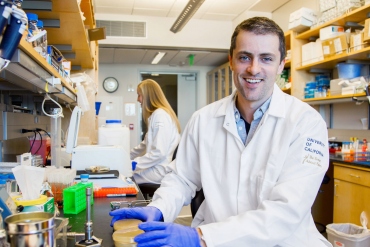Newfound Inhibitors to CRISPR Could Improve Gene Editing
UCSF Researchers Have Discovered 12 New Anti-CRISPR Genes
A constant microscopic battle rages between bacteria and viruses, fueled by a furious arms race. Scientists are repurposing the warring parties’ respective weapons of choice – known as CRISPR and anti-CRISPR – as tools in human gene-editing. The famous CRISPR-Cas system excels at slicing up genomes, while anti-CRISPR can help keep its cuts precise and make gene-editing technology safer.
But for the six known types of CRISPR-Cas system, until recently, scientists had discovered anti-CRISPRs to inhibit only two. Now, UCSF researchers have uncovered 12 new anti-CRISPR genes, some of which can inhibit different CRISPR types and could be critical to future gene-editing therapies.
The scientists were able to spot these elusive genes by spying on their neighbors. Anti-CRISPR genes tend to cluster together, alongside genes known as “anti-CRISPR associated genes.” By starting at recognized anti-CRISPR genetic hubs, or loci, the researchers were able to find more anti-CRISPRs hanging nearby.
“You can use anti-CRISPRs that target one system to find anti-CRISPRs that target a completely different system – anti-CRISPRs that you never found before,” said postdoctoral scholar Nicole Marino, PhD, co-first author of the new research, published in Science on September 6, 2018. In the same issue of the journal, a paper from the Doudna lab at UC Berkeley reports finding one of the same new anti-CRISPR genes by a completely different method.

The UCSF study took place in the lab of Joseph Bondy-Denomy, PhD, who discovered anti-CRISPRs as a graduate student, and is now an assistant professor in the Department of Microbiology and Immunology. Undergraduate researcher Jenny Zhang and graduate student Adair Borges, also first authors on the paper, initially discovered a new anti-CRISPR called F11, which inhibits the Type I CRISPR-Cas system and is broadly distributed across different bacteria. Finding F11 led the team to uncover other new anti-CRISPRs associated with it.
Though now famous as a gene-editing tool, CRISPR actually evolved to protect bacteria from infection by viruses called phages. Phages reproduce by injecting their prey with genetic material, and CRISPR counters their attack by decimating invading genes before they wreak havoc. In turn, phages developed anti-CRISPRs to blunt this bacterial defense system, then bacteria evolved new CRISPR systems in response, and the epic conflict continued through the millennia.
“Phages are under a lot of evolutionary pressure to evolve anti-CRISPRs that can target these different systems simultaneously,” said Marino. “That’s what we think is driving these different anti-CRISPRs together in the genome.”
Over time, bacteria evolved six distinct CRISPR systems, each distinguished by unique gene arrangements and protein components. For example, CRISPR-Cas9 is in the Type II CRISPR-Cas family, while CRISPR-Cas12a is in the Type V family. CRISPR-Cas9 is already heavily used in gene-editing, and its corresponding anti-CRISPR has been shown to reduce off-target and toxic effects inflicted by the system.
CRISPR-Cas12a is being used increasingly for gene editing, but no one had identified any anti-CRISPRs that inhibit a Type V system. Marino set out to find them – and succeeded.
“People will use Cas12a as a gene-editing tool, and this is a way to fine-tune its activity,” said Marino. “CRISPR-based genome editing can cause toxicity in the cell – we want to have a way to shut off this CRISPR-Cas activity, as we need to.”